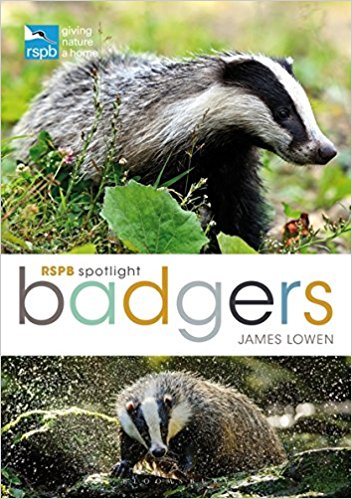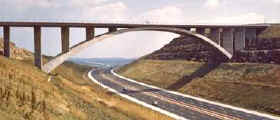New Roads and Badgers
| RSPB Spotlight on Badgers book |
 |
James
Lowen explores the lives of badgers and their communal
living, feeding habits and threats to their conservation. Click
here to buy:
Paperback edition
Kindle edition
|
 So far as road construction is concerned, this can
provide some of the most difficult and damaging effects on badgers and
their setts.
So far as road construction is concerned, this can
provide some of the most difficult and damaging effects on badgers and
their setts.
In the case of housing, it may well be possible to
accommodate the badgers needs, by re-planning the locations of houses, or
alter roads and drainage. In the cases of major roads, once a route has
been decided on, that route will not change, even by a few metres. If
anything, the problems with road construction are getting worse, as modern
roads seem to be built with a plethora of slips roads, roundabouts,
central reservations, road-side drainage, soft verges and so on; and it is often these which really eat
into the green of the countryside. In the "olden-days", roads were
built more in keeping with the lie of the land, and junctions were small,
compact "T" junctions, rather than enormous great roundabouts.
So far as the badgers are concerned, before permission
can be granted various land Surveys will have been done which should have
discovered the presence of any badgers and other protected species. Given the current anti-road lobby,
you can probably expect the presence of badgers to be disclosed to the
planning authorities, who are then legally obliged to take into account
the badgers in granting permission; or setting out conditions attached to
the permissions. That said, it is always worth while notifying your
local Badger Group about
setts, so they can help keep the badgers safe (whether there may be any
new roads or otherwise). As well as helping the badgers, this can also
help safeguard green spaces too.
Whilst remedial action to help Setts threatened by road
schemes is all too often essential, it is far better to try to prevent
problems arising. So if the local Badger Group
or Wildlife Trust are able
to undertake surveys, they should register with the Department of
Transport and the local County Council as consultants, and ask for all new
road schemes to be notified to them as soon as is possible, so that they
can report on the possible effects on the local badger population. The
earlier a road scheme is reported to the local Badger, Group or Wildlife
Trust, the easier it is to minimise the impact on the badgers. This is
especially true where their territorial boundaries are on both sides of
the road, as they will need time to discover where the badgers go
to forage. They will also need to find out whether a sett is in current
continuous use; or whether it is used every now and again; or whether it
is genuinely out of use and has been for a long time. A sett which is
apparently unoccupied in winter, can often return to use in the spring or
summer.
In terms of the setts, these should have been
established by members of the local Badger
Group or a recognised Wildlife or Badger Consultants. If the exact
plans for the road is laid over the sett locations, it may well be the
case that only part of the sett needs to be destroyed; and only a part of
the sett closed. That said, you will need to get a high-resolution map,
such as 1:5,000 or 1:10,000. The maps you buy in the high-street (typically
1:25,000 or 1:50,000) may be fine for walkers, but are not likely to have
enough detail on them for badger or road planning purposes. As a cheaper
alternative,
Google Maps is a very good maps site, which has good aerial photos
too.
The next step is for the badger experts to assess the
likely effect the road will have on the badgers (and other protected
species, like bats and water voles). They will need to have clear answers on how setts will be affected,
how paths will be altered or blocked, how badgers will cross the road and
how their foraging will be affected. This will then lead to suggestions
about building new artificial badger setts (sometimes known as badger bunkers),
Wildlife Bridges or Tunnels/Underpasses and the installation of
badger-proof Fencing. Clearly, this planning stage is of exceptional
importance, not just to the badgers; but also to the accountants who look
after the money. It almost goes without saying that it is an order of
magnitude cheaper to install a wildlife tunnel and then build a road over the
top of it; than to build a road, and then have to excavate a new tunnel
underneath it!
Another health and safety aspect is planning to reduce
wildlife and human casualties. ALL new roads result in an increase in wildlife
casualties for the first few days, weeks and months. Planning issues may
be covered by proper badger-proof fencing (with one-way exit gates to allow badgers to
get off the carriageway). They may also cover the use of road-side warning
signs (for motorists) and Roadside Reflectors (to try and spook wildlife
off the carriageway when headlights are approaching). Hitting a 15kg
badger in a car at high speed will not normally flip the car over, but the
actions taken to avoid a collision may lead to accidents and the loss of
human life. All too often new roads are opened as soon as the road surface
is completed; and the fencing completed afterwards. In order to protect
the wildlife, the fencing ought to be completed before cars are allowed on
the road; and it is hoped that badger licences and planning permissions
will make such requirements mandatory in the future.
Any new artificial sett will normally by built and the
badgers phased into using it over several weeks. Initial familiarity may
lead to them exploring it; with them gradually being excluded from their
existing sett; and their existing sett eventually being filled in or
destroyed. The exact timetable and methods will be specified by a badger
licence obtained by the badger group or the wildlife consultant.
The worst possible scenario for the badger clan is
so-called translocation. This is where it is not possible to expand a part
of their existing sett or to build an new sett nearby; and the badger and
their sett have to be moved as a whole to another location entirely. This
is a last resort, and will be resisted by the vast majority of badgers, badger
groups and consultants. Anecdotal evidence suggests that the technique may
not be all that successful, although more research is needed to find out
why this might be the case.
Real difficulties with translocation projects often lie with finding a
suitable location, which provides a good area for a sett, plentiful food,
good feeding and
foraging grounds, freedom from interference and being far enough away from
other badger groups. In simple terms, putting two different badger clans in
the same territory is likely to result in "war" between the
clans, with extensive fighting, injuries and starvation. Such
stresses in badgers are also likely to result in pregnant sows failing to
produce cubs; and the possible emergence of wildlife infections (it is believed
that the badgers immune system may be depressed when under stress).
As well as all the "technical" research that
badger scientists carry out; a few research projects on translocation
projects would be very useful; as it would allow for far better planning
and decision making by badger groups and English Nature licence providers.

|
